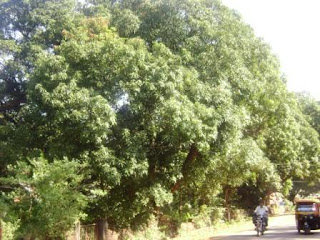Urban trees serve many useful functions such as climate change mitigation by carbon sequestration, air quality improvement by air pollution abatement, biodiversity conservation and source of ecosystem goods to urban inhabitants. They also have aesthetic, socio-religious and recreational value in urban contexts. In spite of the importance, they have not received much scientific attention. we ( Shivananda Bhat, Jayakara Bhandary & Syed Fasihuddin, Department of Botany, Govt. College, Karwar) have investigated the diversity and density of tree species growing both within the built environment as well as road-side avenues in the seaside town of Karwar which is the administrative headquarters of Uttara Kannada district of Karnataka. The total area of the town is 27.15 km2 and population (2001 census) is 62,973.
The tree flora of Karwar comprises of about 106 species in which about 70% are indigenous species. The other 30% involves exotic and introducedd species. The top five dominant species are Mangifera indica (Wild mango, 20.016% of total tree population), Polyalthia longifolia (False Ashoka, 12.544%), Peltophorum pterocarpum ( Yellow flame tree, 6.763%), Samania saman (Rain tree, 5.072%) and Artocarpus heterophyllus (Jackfruit, 5.045%). The tree diversity represents a good assemblage of different utility categories such as wild and cultivated fruit yielding trees, shade and ornamental trees, sacred and religious trees, etc. Besides the high proportion of older trees of wild mango and jackfruit, presence of other wild fruit yielding trees like Artocarpus incisus and Spondias pinnata, large sized sacred trees such as Ficus religiosa and F. benghalensis, rare medicinal species such as Garcinia indica, Saraca asoca, Terminalia bellirica, etc., are some of the notable features of the urban tree flora of Karwar.
Old gigantic trees cooling the heart of Karwar town |
Tree shades - a hub of activities |
Avenue trees of Karwar |
A 300 year old sacred Syzygium cumini tree |
Wild mango trees - dominant tree of Karwar |
This is, in fact, the summary abstract of this project presented at Lake 2011 Conference held at Indian Institute of Sciences, Bangalore, from 22nd to 24th December 2011.













